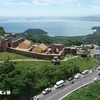
Hanoi (VNA) - Located about 15 kilometers from the center of Hue city, Ru Cha is not only famous for its mysterious beauty but also known as the only remaining primeval mangrove forest in the largest lagoon system in Southeast Asia – Tam Giang Lagoon.
The name of the forest is intriguing and mysterious, and according to locals, “Ru” means forest, while “Cha” refers to the most typical tree species in the area, which grows on over 90% of the forest.
The forest initially spanned nearly 3.9 hectares, mostly consisting of large Cha trees. Over time, the forest was expanded by more than 18 hectares, with additional species such as mangrove, nipa palm, and red mangrove.
The mysterious beauty of Ru Cha comes from the thousands of Cha trees standing closely together, their large roots tightly embedded in the ground. Over 90% of the forest's space is covered by these intertwined trees, forming a canopy above the pathway running through the forest.
Though the forest is not rich in species diversity, it plays an important role in the wetland ecosystem. This rare, pristine forest serves as a “green wall,” helping to mitigate the damage caused by natural disasters, protect dikes, and increase resilience to the impacts of climate change.
The pristine landscape and beauty of Ru Cha attract many tourists. Visitors can rent small boats to navigate through the forest, exploring the area filled with the singing of birds, or walk along the winding concrete paths through the forest, surrounded by the strange shapes of the Cha tree roots. These activities provide an exciting and memorable experience.
Along the paths through the forest, the vivid and realistic landscape of the Ru Cha mangrove forest will unfold before visitors. Especially during the day, sunlight filters through the leaves, creating tiny light beams that dance across the forest floor.
Ru Cha is at its best during the autumn, when the forest turns golden and red, creating a breathtaking view, and the weather becomes more pleasant. For a full view of the beauty of Ru Cha in autumn, you can visit the observation tower.
However, visitors should note that Hue often experiences afternoon rains during this time of the year, so morning visits are the best choice for taking photos.
In 2020, Thua Thien-Hue province approved a project to develop mangrove forests in Huong Phong commune with the task of strictly protecting the existing 21.9 hectares of forest and preserving the biodiversity of the mangrove ecosystem, particularly Ru Cha.
The project's aim is to identify areas for planting mangroves, select appropriate plant species, and plant new mangrove forests on 232.84 hectares to enhance environmental protection, support sustainable aquaculture development, and boost ecotourism.
Another important task of the project is to build a mangrove plant garden with around 30 species representing the three regions of Vietnam (North, Central, and South) to meet the growing demand for scientific research, education, and training on mangrove plants and ecosystems for students and researchers.

Ru Cha gained more fame in 2021 when photographer Pham Huy Trung's work "Fishing in the Mangrove Forest" won first place in the People category at the prestigious Drone Photo Awards 2021.
Trung took the photo during the winter at Ru Cha. The aerial shot shows the bare Cha trees with their intertwined branches over the water, creating a striking image. The photographer emphasises the figure of the fisherman in the centre, with harmonious lighting creating an exquisite composition./.
























